Analysis of Conflicts in Employment Relationship
VerifiedAdded on 2021/02/22
|10
|2938
|49
AI Summary
The assignment provides an in-depth analysis of conflicts that may occur in employment relationships, including wages and benefits, inconsistent safety standards, and conflicts between unions and management. It also discusses the role of trade unions in managing conflicts, including collective bargaining, and examines different approaches to conflict management, such as human resource theory, equity theory, unitarism, pluralistic approach, Unitary approach, and Radical approach.
Contribute Materials
Your contribution can guide someone’s learning journey. Share your
documents today.
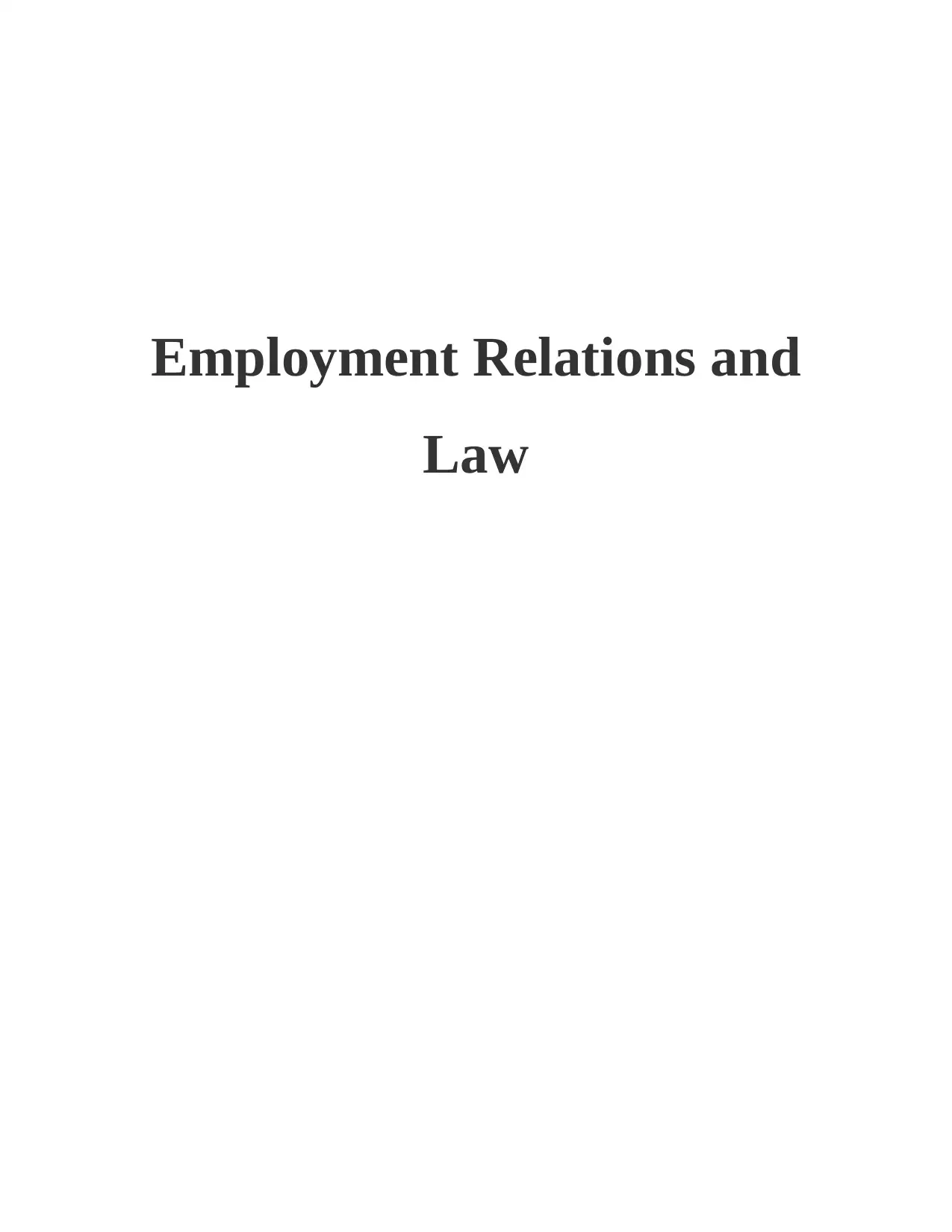
Employment Relations and
Law
Law
Secure Best Marks with AI Grader
Need help grading? Try our AI Grader for instant feedback on your assignments.

TABLE OF CONTENTS
INTRODUCTION ..........................................................................................................................3
ASSIGNMENT 1.............................................................................................................................3
(Covered in PPT).........................................................................................................................3
ASSESSMENT 2.............................................................................................................................3
Conflicts that might occur in employment relationship..............................................................3
Role of trade union in managing conflicts..................................................................................4
Outline of various conflicts that might complicates employment relationship...........................4
Critical evaluation of different conflicts in employment relationship using theories.................5
Role of trade union and changing trends with the perspective of unitary, pluralist and radical. 5
Organisational approaches to manage the employment relationship and trade unions in BP.....6
Different approaches to trade unions in Chevron corporation....................................................7
CONCLUSION................................................................................................................................7
REFERENCES................................................................................................................................8
INTRODUCTION ..........................................................................................................................3
ASSIGNMENT 1.............................................................................................................................3
(Covered in PPT).........................................................................................................................3
ASSESSMENT 2.............................................................................................................................3
Conflicts that might occur in employment relationship..............................................................3
Role of trade union in managing conflicts..................................................................................4
Outline of various conflicts that might complicates employment relationship...........................4
Critical evaluation of different conflicts in employment relationship using theories.................5
Role of trade union and changing trends with the perspective of unitary, pluralist and radical. 5
Organisational approaches to manage the employment relationship and trade unions in BP.....6
Different approaches to trade unions in Chevron corporation....................................................7
CONCLUSION................................................................................................................................7
REFERENCES................................................................................................................................8

INTRODUCTION
The Human resource management help, support and train the managers of the
organisation in order to build effective working relation with the union(Bratton & Gold, 2017).
Employment relations are concerned with managing and maintaining the employment
relationship, which involves handling the pay-work bargain, dealing with employment practices,
issues arsing from employment, providing employees with a voice and also communicating with
them(Armstrong, 2009). Industrial relation is basically the legal link between the employees and
its employers and labours are having various legal rights that can safe them from any
misconducts that arise in the firm. Present study is based on three companies that are following
trade union:- The British Petroleum Company plc that is a British Multinational oil and gas
company founded in the year 1909 by William Knox D'Arcy. BP is a public company and is the
largest oil and gas producer in Trinidad and Tobago and it is one of the largest LNG plants in
Western Hemisphere. Another is Chevron Corporation that is an American multinational energy
corporation founded in the year 1879 and is having 51,900 working employees and at last about
the company Black and Decker that is not following any trade union and is a manufacturing
company founded in the year 1910 by Baltimore. Report will include Conflicts that might occur
in employment relationship and role of trade union in managing conflicts. It will further outline
various conflicts that might complicates employment relationship. Report will also evaluate
different conflicts in employment relationship using theories and role of trade union and
changing trends with the perspective of unitary, pluralist and radical. In Pluralistic approach
there is number of sources of power with respect to relationship between workers and leaders, on
the other side in unitary approach to develop the organisation all stakeholders along with the
workers have agreement with direction of project and according to radical approach inequality is
seen between the employees and management that's why employees are in need to gain power as
they don't want to be exploited under a mismanagement of the employers. In BP Radical
approach is been used in order to help the workers in getting proper wages. Further report will
include organisational approaches to manage the employment relationship and trade unions in
BP and also different approaches to trade unions in Chevron corporation and Black and
Decker.
The Human resource management help, support and train the managers of the
organisation in order to build effective working relation with the union(Bratton & Gold, 2017).
Employment relations are concerned with managing and maintaining the employment
relationship, which involves handling the pay-work bargain, dealing with employment practices,
issues arsing from employment, providing employees with a voice and also communicating with
them(Armstrong, 2009). Industrial relation is basically the legal link between the employees and
its employers and labours are having various legal rights that can safe them from any
misconducts that arise in the firm. Present study is based on three companies that are following
trade union:- The British Petroleum Company plc that is a British Multinational oil and gas
company founded in the year 1909 by William Knox D'Arcy. BP is a public company and is the
largest oil and gas producer in Trinidad and Tobago and it is one of the largest LNG plants in
Western Hemisphere. Another is Chevron Corporation that is an American multinational energy
corporation founded in the year 1879 and is having 51,900 working employees and at last about
the company Black and Decker that is not following any trade union and is a manufacturing
company founded in the year 1910 by Baltimore. Report will include Conflicts that might occur
in employment relationship and role of trade union in managing conflicts. It will further outline
various conflicts that might complicates employment relationship. Report will also evaluate
different conflicts in employment relationship using theories and role of trade union and
changing trends with the perspective of unitary, pluralist and radical. In Pluralistic approach
there is number of sources of power with respect to relationship between workers and leaders, on
the other side in unitary approach to develop the organisation all stakeholders along with the
workers have agreement with direction of project and according to radical approach inequality is
seen between the employees and management that's why employees are in need to gain power as
they don't want to be exploited under a mismanagement of the employers. In BP Radical
approach is been used in order to help the workers in getting proper wages. Further report will
include organisational approaches to manage the employment relationship and trade unions in
BP and also different approaches to trade unions in Chevron corporation and Black and
Decker.
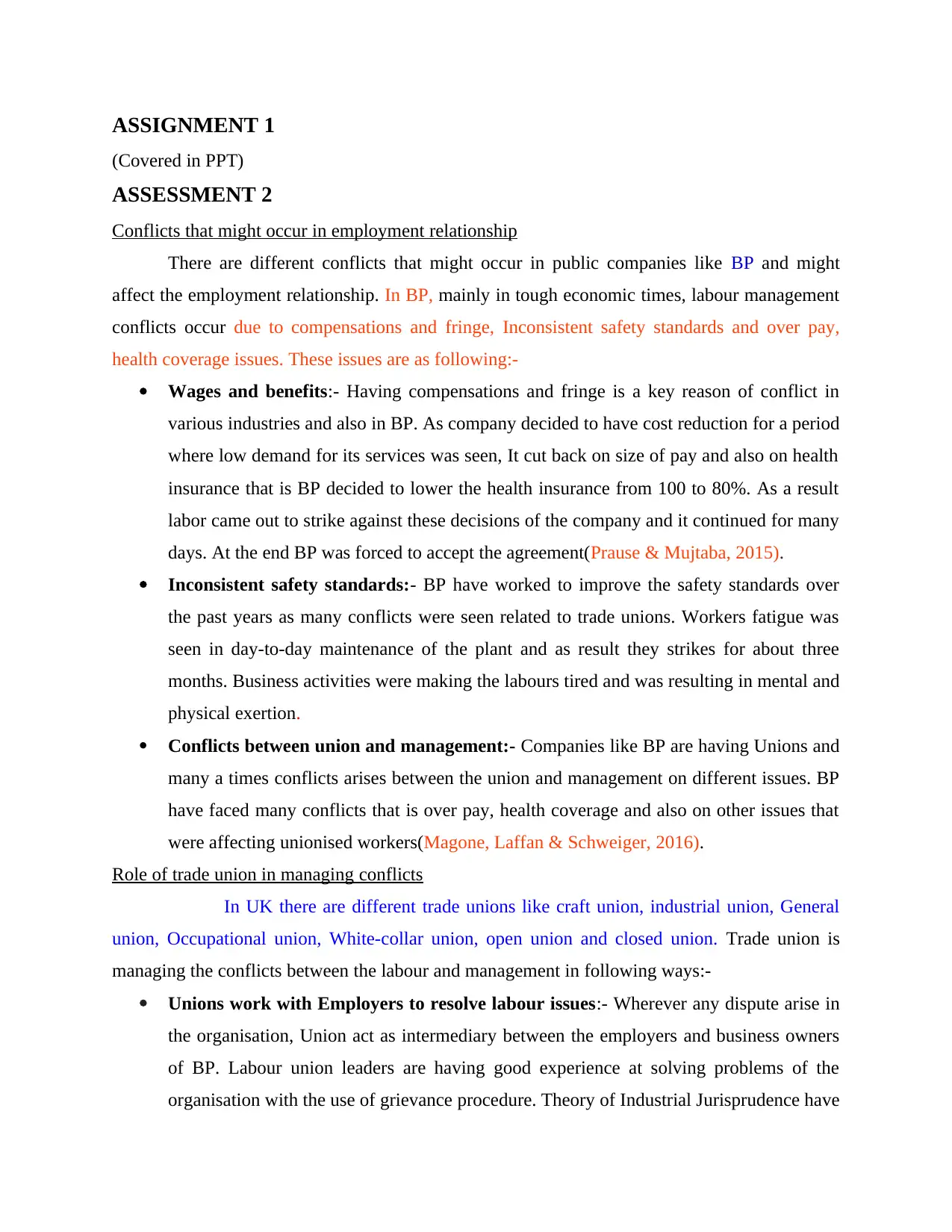
ASSIGNMENT 1
(Covered in PPT)
ASSESSMENT 2
Conflicts that might occur in employment relationship
There are different conflicts that might occur in public companies like BP and might
affect the employment relationship. In BP, mainly in tough economic times, labour management
conflicts occur due to compensations and fringe, Inconsistent safety standards and over pay,
health coverage issues. These issues are as following:-
Wages and benefits:- Having compensations and fringe is a key reason of conflict in
various industries and also in BP. As company decided to have cost reduction for a period
where low demand for its services was seen, It cut back on size of pay and also on health
insurance that is BP decided to lower the health insurance from 100 to 80%. As a result
labor came out to strike against these decisions of the company and it continued for many
days. At the end BP was forced to accept the agreement(Prause & Mujtaba, 2015).
Inconsistent safety standards:- BP have worked to improve the safety standards over
the past years as many conflicts were seen related to trade unions. Workers fatigue was
seen in day-to-day maintenance of the plant and as result they strikes for about three
months. Business activities were making the labours tired and was resulting in mental and
physical exertion.
Conflicts between union and management:- Companies like BP are having Unions and
many a times conflicts arises between the union and management on different issues. BP
have faced many conflicts that is over pay, health coverage and also on other issues that
were affecting unionised workers(Magone, Laffan & Schweiger, 2016).
Role of trade union in managing conflicts
In UK there are different trade unions like craft union, industrial union, General
union, Occupational union, White-collar union, open union and closed union. Trade union is
managing the conflicts between the labour and management in following ways:-
Unions work with Employers to resolve labour issues:- Wherever any dispute arise in
the organisation, Union act as intermediary between the employers and business owners
of BP. Labour union leaders are having good experience at solving problems of the
organisation with the use of grievance procedure. Theory of Industrial Jurisprudence have
(Covered in PPT)
ASSESSMENT 2
Conflicts that might occur in employment relationship
There are different conflicts that might occur in public companies like BP and might
affect the employment relationship. In BP, mainly in tough economic times, labour management
conflicts occur due to compensations and fringe, Inconsistent safety standards and over pay,
health coverage issues. These issues are as following:-
Wages and benefits:- Having compensations and fringe is a key reason of conflict in
various industries and also in BP. As company decided to have cost reduction for a period
where low demand for its services was seen, It cut back on size of pay and also on health
insurance that is BP decided to lower the health insurance from 100 to 80%. As a result
labor came out to strike against these decisions of the company and it continued for many
days. At the end BP was forced to accept the agreement(Prause & Mujtaba, 2015).
Inconsistent safety standards:- BP have worked to improve the safety standards over
the past years as many conflicts were seen related to trade unions. Workers fatigue was
seen in day-to-day maintenance of the plant and as result they strikes for about three
months. Business activities were making the labours tired and was resulting in mental and
physical exertion.
Conflicts between union and management:- Companies like BP are having Unions and
many a times conflicts arises between the union and management on different issues. BP
have faced many conflicts that is over pay, health coverage and also on other issues that
were affecting unionised workers(Magone, Laffan & Schweiger, 2016).
Role of trade union in managing conflicts
In UK there are different trade unions like craft union, industrial union, General
union, Occupational union, White-collar union, open union and closed union. Trade union is
managing the conflicts between the labour and management in following ways:-
Unions work with Employers to resolve labour issues:- Wherever any dispute arise in
the organisation, Union act as intermediary between the employers and business owners
of BP. Labour union leaders are having good experience at solving problems of the
organisation with the use of grievance procedure. Theory of Industrial Jurisprudence have
Secure Best Marks with AI Grader
Need help grading? Try our AI Grader for instant feedback on your assignments.
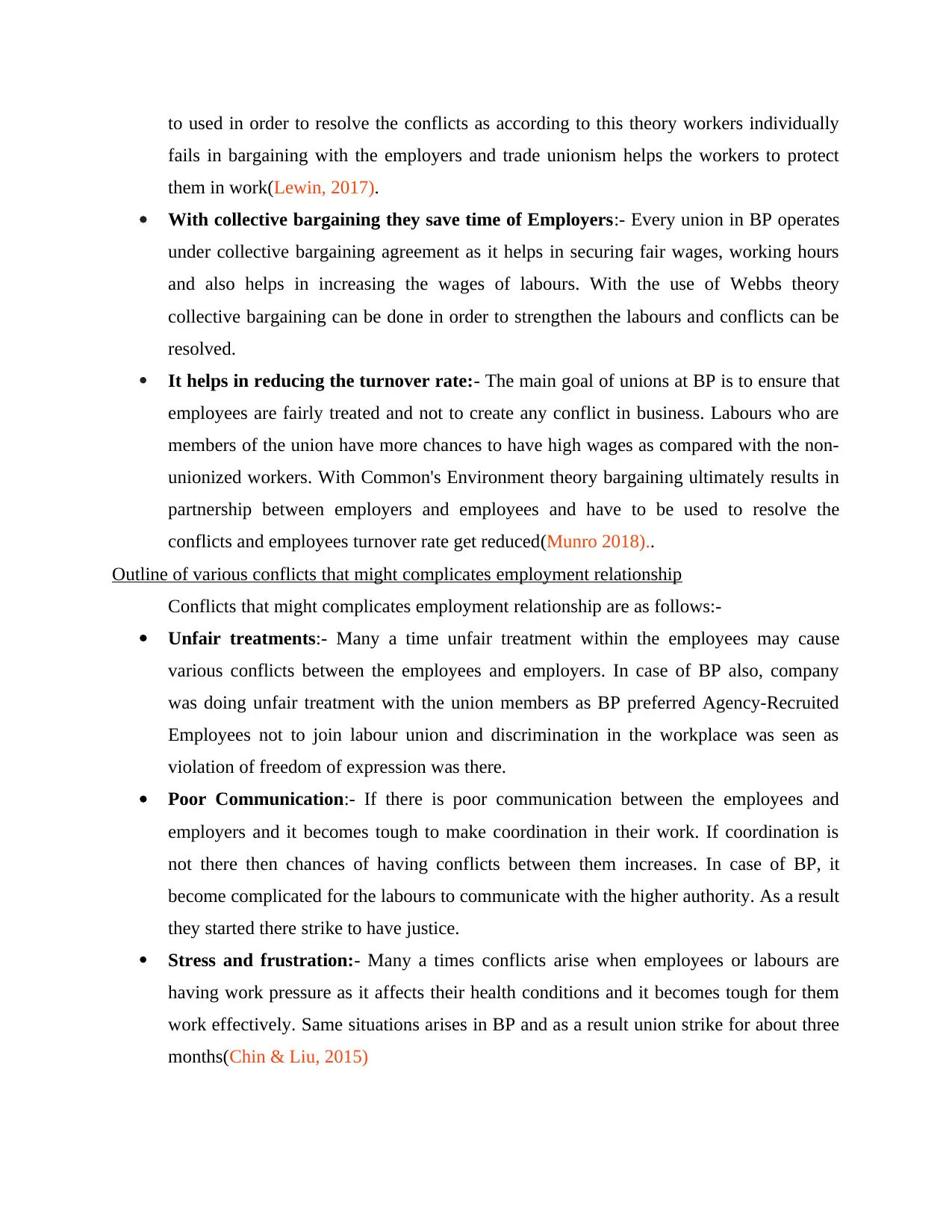
to used in order to resolve the conflicts as according to this theory workers individually
fails in bargaining with the employers and trade unionism helps the workers to protect
them in work(Lewin, 2017).
With collective bargaining they save time of Employers:- Every union in BP operates
under collective bargaining agreement as it helps in securing fair wages, working hours
and also helps in increasing the wages of labours. With the use of Webbs theory
collective bargaining can be done in order to strengthen the labours and conflicts can be
resolved.
It helps in reducing the turnover rate:- The main goal of unions at BP is to ensure that
employees are fairly treated and not to create any conflict in business. Labours who are
members of the union have more chances to have high wages as compared with the non-
unionized workers. With Common's Environment theory bargaining ultimately results in
partnership between employers and employees and have to be used to resolve the
conflicts and employees turnover rate get reduced(Munro 2018)..
Outline of various conflicts that might complicates employment relationship
Conflicts that might complicates employment relationship are as follows:-
Unfair treatments:- Many a time unfair treatment within the employees may cause
various conflicts between the employees and employers. In case of BP also, company
was doing unfair treatment with the union members as BP preferred Agency-Recruited
Employees not to join labour union and discrimination in the workplace was seen as
violation of freedom of expression was there.
Poor Communication:- If there is poor communication between the employees and
employers and it becomes tough to make coordination in their work. If coordination is
not there then chances of having conflicts between them increases. In case of BP, it
become complicated for the labours to communicate with the higher authority. As a result
they started there strike to have justice.
Stress and frustration:- Many a times conflicts arise when employees or labours are
having work pressure as it affects their health conditions and it becomes tough for them
work effectively. Same situations arises in BP and as a result union strike for about three
months(Chin & Liu, 2015)
fails in bargaining with the employers and trade unionism helps the workers to protect
them in work(Lewin, 2017).
With collective bargaining they save time of Employers:- Every union in BP operates
under collective bargaining agreement as it helps in securing fair wages, working hours
and also helps in increasing the wages of labours. With the use of Webbs theory
collective bargaining can be done in order to strengthen the labours and conflicts can be
resolved.
It helps in reducing the turnover rate:- The main goal of unions at BP is to ensure that
employees are fairly treated and not to create any conflict in business. Labours who are
members of the union have more chances to have high wages as compared with the non-
unionized workers. With Common's Environment theory bargaining ultimately results in
partnership between employers and employees and have to be used to resolve the
conflicts and employees turnover rate get reduced(Munro 2018)..
Outline of various conflicts that might complicates employment relationship
Conflicts that might complicates employment relationship are as follows:-
Unfair treatments:- Many a time unfair treatment within the employees may cause
various conflicts between the employees and employers. In case of BP also, company
was doing unfair treatment with the union members as BP preferred Agency-Recruited
Employees not to join labour union and discrimination in the workplace was seen as
violation of freedom of expression was there.
Poor Communication:- If there is poor communication between the employees and
employers and it becomes tough to make coordination in their work. If coordination is
not there then chances of having conflicts between them increases. In case of BP, it
become complicated for the labours to communicate with the higher authority. As a result
they started there strike to have justice.
Stress and frustration:- Many a times conflicts arise when employees or labours are
having work pressure as it affects their health conditions and it becomes tough for them
work effectively. Same situations arises in BP and as a result union strike for about three
months(Chin & Liu, 2015)
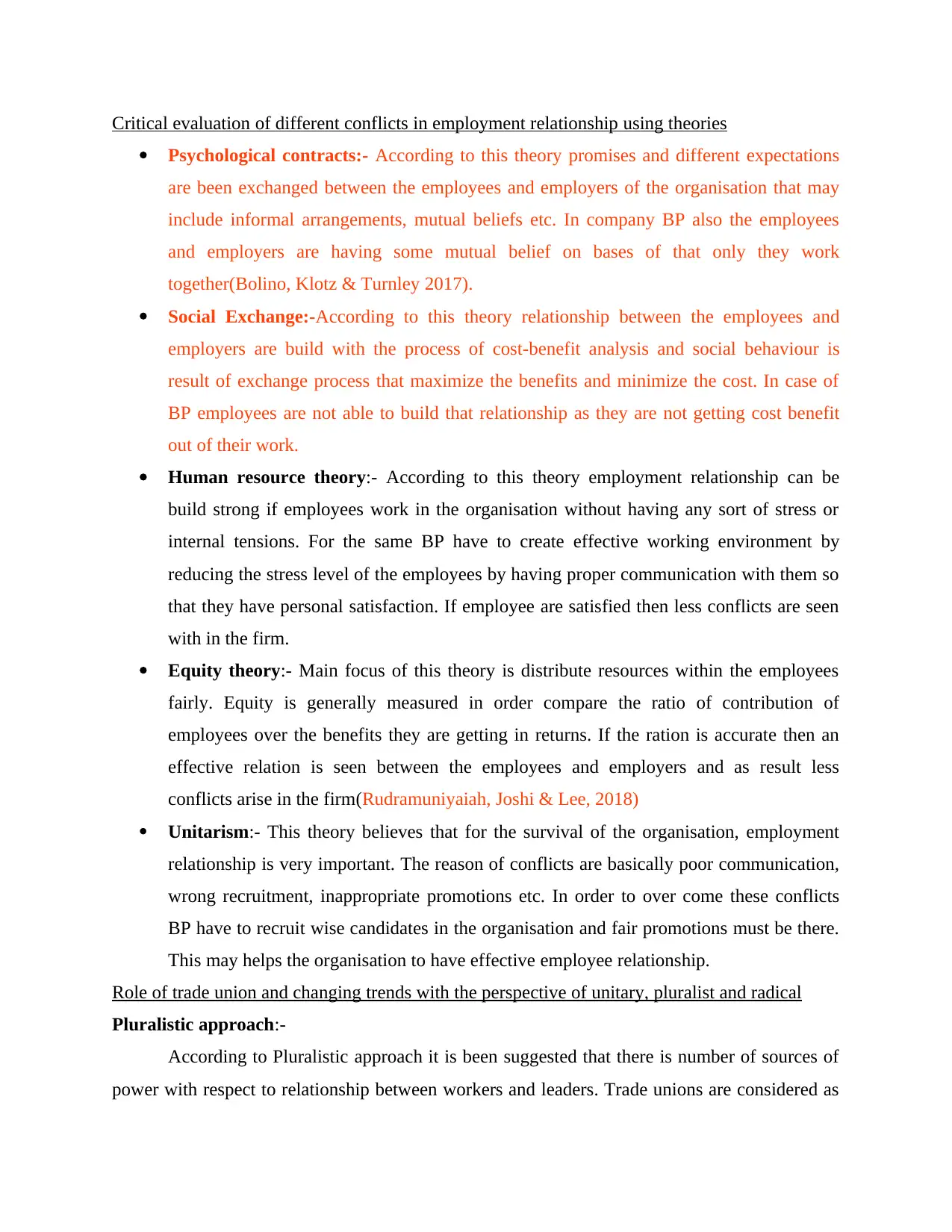
Critical evaluation of different conflicts in employment relationship using theories
Psychological contracts:- According to this theory promises and different expectations
are been exchanged between the employees and employers of the organisation that may
include informal arrangements, mutual beliefs etc. In company BP also the employees
and employers are having some mutual belief on bases of that only they work
together(Bolino, Klotz & Turnley 2017).
Social Exchange:-According to this theory relationship between the employees and
employers are build with the process of cost-benefit analysis and social behaviour is
result of exchange process that maximize the benefits and minimize the cost. In case of
BP employees are not able to build that relationship as they are not getting cost benefit
out of their work.
Human resource theory:- According to this theory employment relationship can be
build strong if employees work in the organisation without having any sort of stress or
internal tensions. For the same BP have to create effective working environment by
reducing the stress level of the employees by having proper communication with them so
that they have personal satisfaction. If employee are satisfied then less conflicts are seen
with in the firm.
Equity theory:- Main focus of this theory is distribute resources within the employees
fairly. Equity is generally measured in order compare the ratio of contribution of
employees over the benefits they are getting in returns. If the ration is accurate then an
effective relation is seen between the employees and employers and as result less
conflicts arise in the firm(Rudramuniyaiah, Joshi & Lee, 2018)
Unitarism:- This theory believes that for the survival of the organisation, employment
relationship is very important. The reason of conflicts are basically poor communication,
wrong recruitment, inappropriate promotions etc. In order to over come these conflicts
BP have to recruit wise candidates in the organisation and fair promotions must be there.
This may helps the organisation to have effective employee relationship.
Role of trade union and changing trends with the perspective of unitary, pluralist and radical
Pluralistic approach:-
According to Pluralistic approach it is been suggested that there is number of sources of
power with respect to relationship between workers and leaders. Trade unions are considered as
Psychological contracts:- According to this theory promises and different expectations
are been exchanged between the employees and employers of the organisation that may
include informal arrangements, mutual beliefs etc. In company BP also the employees
and employers are having some mutual belief on bases of that only they work
together(Bolino, Klotz & Turnley 2017).
Social Exchange:-According to this theory relationship between the employees and
employers are build with the process of cost-benefit analysis and social behaviour is
result of exchange process that maximize the benefits and minimize the cost. In case of
BP employees are not able to build that relationship as they are not getting cost benefit
out of their work.
Human resource theory:- According to this theory employment relationship can be
build strong if employees work in the organisation without having any sort of stress or
internal tensions. For the same BP have to create effective working environment by
reducing the stress level of the employees by having proper communication with them so
that they have personal satisfaction. If employee are satisfied then less conflicts are seen
with in the firm.
Equity theory:- Main focus of this theory is distribute resources within the employees
fairly. Equity is generally measured in order compare the ratio of contribution of
employees over the benefits they are getting in returns. If the ration is accurate then an
effective relation is seen between the employees and employers and as result less
conflicts arise in the firm(Rudramuniyaiah, Joshi & Lee, 2018)
Unitarism:- This theory believes that for the survival of the organisation, employment
relationship is very important. The reason of conflicts are basically poor communication,
wrong recruitment, inappropriate promotions etc. In order to over come these conflicts
BP have to recruit wise candidates in the organisation and fair promotions must be there.
This may helps the organisation to have effective employee relationship.
Role of trade union and changing trends with the perspective of unitary, pluralist and radical
Pluralistic approach:-
According to Pluralistic approach it is been suggested that there is number of sources of
power with respect to relationship between workers and leaders. Trade unions are considered as
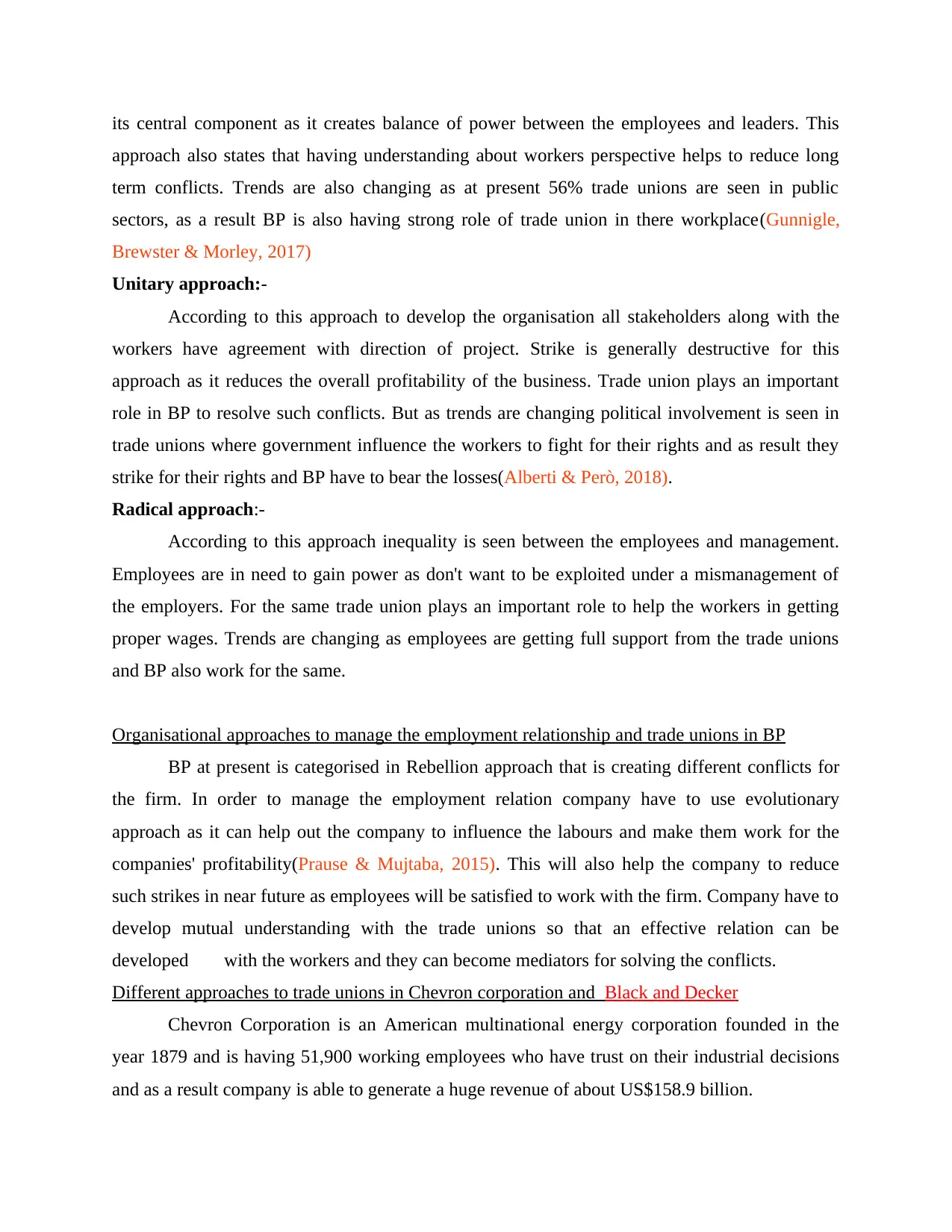
its central component as it creates balance of power between the employees and leaders. This
approach also states that having understanding about workers perspective helps to reduce long
term conflicts. Trends are also changing as at present 56% trade unions are seen in public
sectors, as a result BP is also having strong role of trade union in there workplace(Gunnigle,
Brewster & Morley, 2017)
Unitary approach:-
According to this approach to develop the organisation all stakeholders along with the
workers have agreement with direction of project. Strike is generally destructive for this
approach as it reduces the overall profitability of the business. Trade union plays an important
role in BP to resolve such conflicts. But as trends are changing political involvement is seen in
trade unions where government influence the workers to fight for their rights and as result they
strike for their rights and BP have to bear the losses(Alberti & Però, 2018).
Radical approach:-
According to this approach inequality is seen between the employees and management.
Employees are in need to gain power as don't want to be exploited under a mismanagement of
the employers. For the same trade union plays an important role to help the workers in getting
proper wages. Trends are changing as employees are getting full support from the trade unions
and BP also work for the same.
Organisational approaches to manage the employment relationship and trade unions in BP
BP at present is categorised in Rebellion approach that is creating different conflicts for
the firm. In order to manage the employment relation company have to use evolutionary
approach as it can help out the company to influence the labours and make them work for the
companies' profitability(Prause & Mujtaba, 2015). This will also help the company to reduce
such strikes in near future as employees will be satisfied to work with the firm. Company have to
develop mutual understanding with the trade unions so that an effective relation can be
developed with the workers and they can become mediators for solving the conflicts.
Different approaches to trade unions in Chevron corporation and Black and Decker
Chevron Corporation is an American multinational energy corporation founded in the
year 1879 and is having 51,900 working employees who have trust on their industrial decisions
and as a result company is able to generate a huge revenue of about US$158.9 billion.
approach also states that having understanding about workers perspective helps to reduce long
term conflicts. Trends are also changing as at present 56% trade unions are seen in public
sectors, as a result BP is also having strong role of trade union in there workplace(Gunnigle,
Brewster & Morley, 2017)
Unitary approach:-
According to this approach to develop the organisation all stakeholders along with the
workers have agreement with direction of project. Strike is generally destructive for this
approach as it reduces the overall profitability of the business. Trade union plays an important
role in BP to resolve such conflicts. But as trends are changing political involvement is seen in
trade unions where government influence the workers to fight for their rights and as result they
strike for their rights and BP have to bear the losses(Alberti & Però, 2018).
Radical approach:-
According to this approach inequality is seen between the employees and management.
Employees are in need to gain power as don't want to be exploited under a mismanagement of
the employers. For the same trade union plays an important role to help the workers in getting
proper wages. Trends are changing as employees are getting full support from the trade unions
and BP also work for the same.
Organisational approaches to manage the employment relationship and trade unions in BP
BP at present is categorised in Rebellion approach that is creating different conflicts for
the firm. In order to manage the employment relation company have to use evolutionary
approach as it can help out the company to influence the labours and make them work for the
companies' profitability(Prause & Mujtaba, 2015). This will also help the company to reduce
such strikes in near future as employees will be satisfied to work with the firm. Company have to
develop mutual understanding with the trade unions so that an effective relation can be
developed with the workers and they can become mediators for solving the conflicts.
Different approaches to trade unions in Chevron corporation and Black and Decker
Chevron Corporation is an American multinational energy corporation founded in the
year 1879 and is having 51,900 working employees who have trust on their industrial decisions
and as a result company is able to generate a huge revenue of about US$158.9 billion.
Paraphrase This Document
Need a fresh take? Get an instant paraphrase of this document with our AI Paraphraser
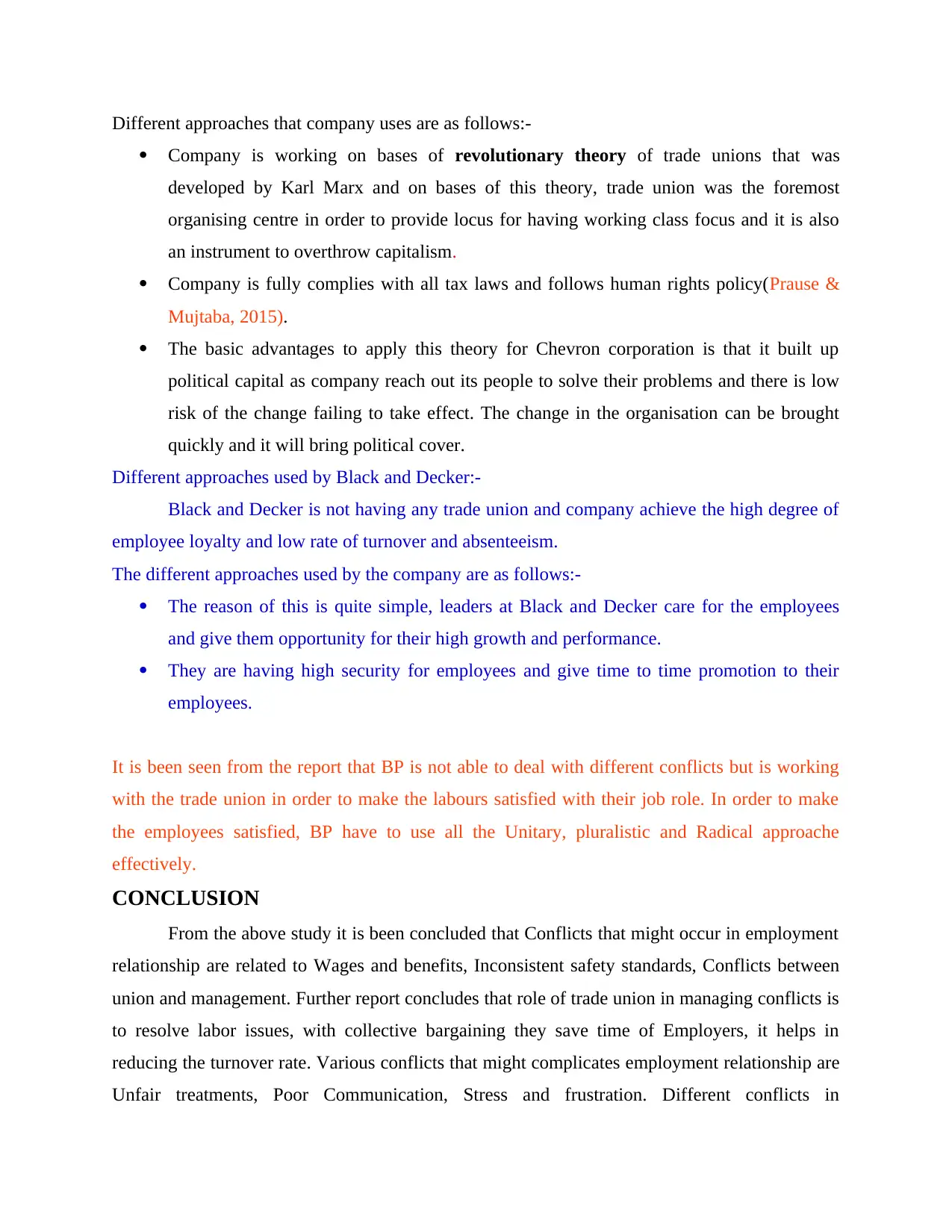
Different approaches that company uses are as follows:-
Company is working on bases of revolutionary theory of trade unions that was
developed by Karl Marx and on bases of this theory, trade union was the foremost
organising centre in order to provide locus for having working class focus and it is also
an instrument to overthrow capitalism.
Company is fully complies with all tax laws and follows human rights policy(Prause &
Mujtaba, 2015).
The basic advantages to apply this theory for Chevron corporation is that it built up
political capital as company reach out its people to solve their problems and there is low
risk of the change failing to take effect. The change in the organisation can be brought
quickly and it will bring political cover.
Different approaches used by Black and Decker:-
Black and Decker is not having any trade union and company achieve the high degree of
employee loyalty and low rate of turnover and absenteeism.
The different approaches used by the company are as follows:-
The reason of this is quite simple, leaders at Black and Decker care for the employees
and give them opportunity for their high growth and performance.
They are having high security for employees and give time to time promotion to their
employees.
It is been seen from the report that BP is not able to deal with different conflicts but is working
with the trade union in order to make the labours satisfied with their job role. In order to make
the employees satisfied, BP have to use all the Unitary, pluralistic and Radical approache
effectively.
CONCLUSION
From the above study it is been concluded that Conflicts that might occur in employment
relationship are related to Wages and benefits, Inconsistent safety standards, Conflicts between
union and management. Further report concludes that role of trade union in managing conflicts is
to resolve labor issues, with collective bargaining they save time of Employers, it helps in
reducing the turnover rate. Various conflicts that might complicates employment relationship are
Unfair treatments, Poor Communication, Stress and frustration. Different conflicts in
Company is working on bases of revolutionary theory of trade unions that was
developed by Karl Marx and on bases of this theory, trade union was the foremost
organising centre in order to provide locus for having working class focus and it is also
an instrument to overthrow capitalism.
Company is fully complies with all tax laws and follows human rights policy(Prause &
Mujtaba, 2015).
The basic advantages to apply this theory for Chevron corporation is that it built up
political capital as company reach out its people to solve their problems and there is low
risk of the change failing to take effect. The change in the organisation can be brought
quickly and it will bring political cover.
Different approaches used by Black and Decker:-
Black and Decker is not having any trade union and company achieve the high degree of
employee loyalty and low rate of turnover and absenteeism.
The different approaches used by the company are as follows:-
The reason of this is quite simple, leaders at Black and Decker care for the employees
and give them opportunity for their high growth and performance.
They are having high security for employees and give time to time promotion to their
employees.
It is been seen from the report that BP is not able to deal with different conflicts but is working
with the trade union in order to make the labours satisfied with their job role. In order to make
the employees satisfied, BP have to use all the Unitary, pluralistic and Radical approache
effectively.
CONCLUSION
From the above study it is been concluded that Conflicts that might occur in employment
relationship are related to Wages and benefits, Inconsistent safety standards, Conflicts between
union and management. Further report concludes that role of trade union in managing conflicts is
to resolve labor issues, with collective bargaining they save time of Employers, it helps in
reducing the turnover rate. Various conflicts that might complicates employment relationship are
Unfair treatments, Poor Communication, Stress and frustration. Different conflicts in
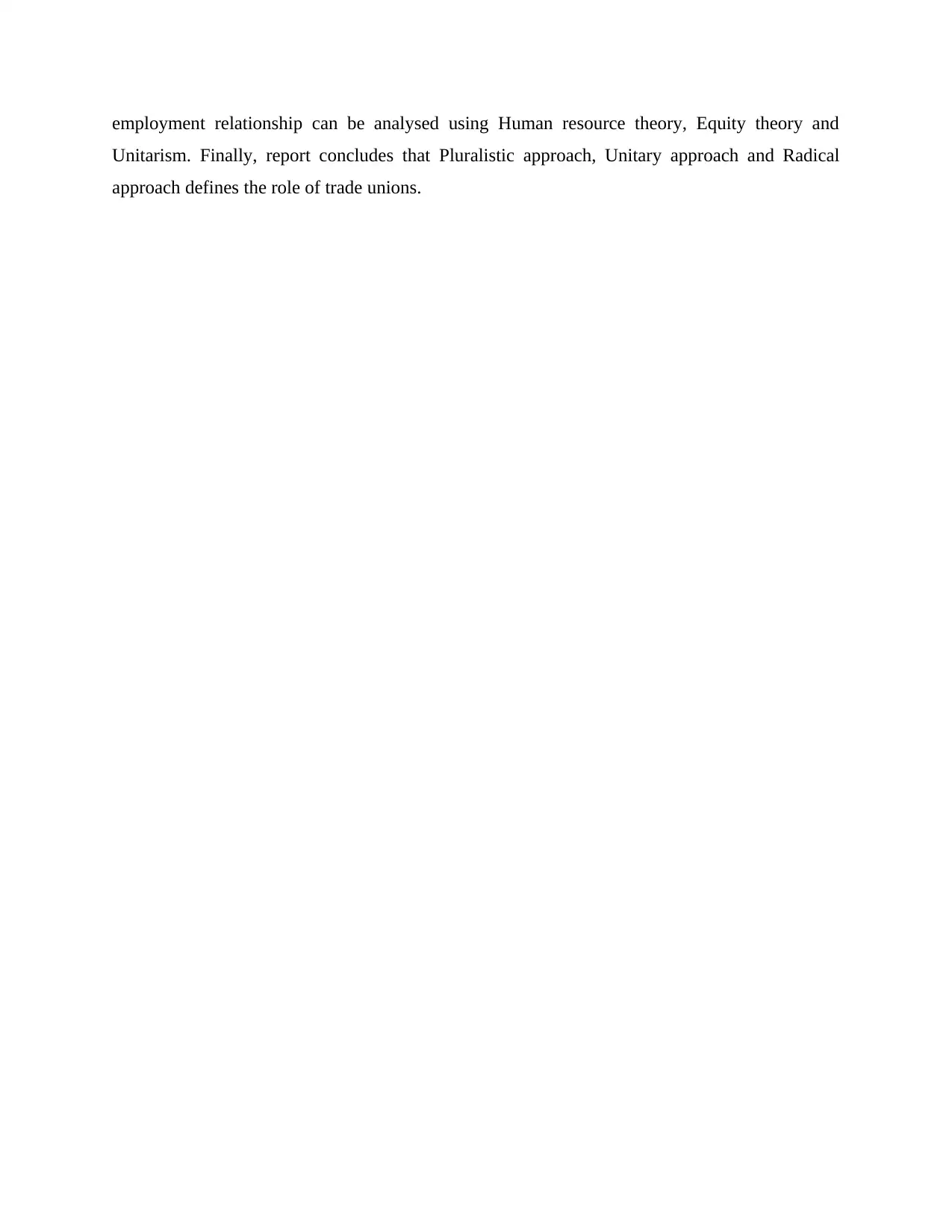
employment relationship can be analysed using Human resource theory, Equity theory and
Unitarism. Finally, report concludes that Pluralistic approach, Unitary approach and Radical
approach defines the role of trade unions.
Unitarism. Finally, report concludes that Pluralistic approach, Unitary approach and Radical
approach defines the role of trade unions.
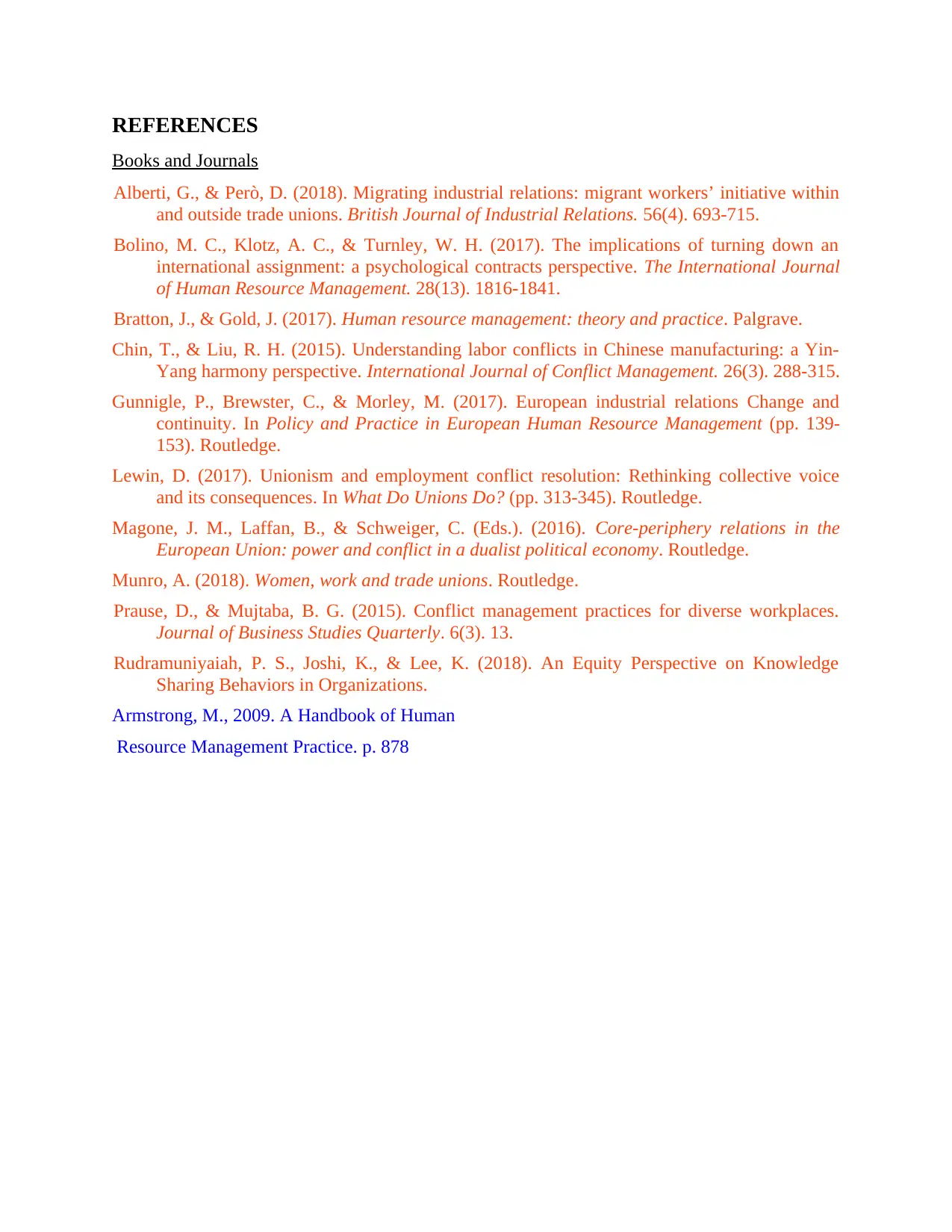
REFERENCES
Books and Journals
Alberti, G., & Però, D. (2018). Migrating industrial relations: migrant workers’ initiative within
and outside trade unions. British Journal of Industrial Relations. 56(4). 693-715.
Bolino, M. C., Klotz, A. C., & Turnley, W. H. (2017). The implications of turning down an
international assignment: a psychological contracts perspective. The International Journal
of Human Resource Management. 28(13). 1816-1841.
Bratton, J., & Gold, J. (2017). Human resource management: theory and practice. Palgrave.
Chin, T., & Liu, R. H. (2015). Understanding labor conflicts in Chinese manufacturing: a Yin-
Yang harmony perspective. International Journal of Conflict Management. 26(3). 288-315.
Gunnigle, P., Brewster, C., & Morley, M. (2017). European industrial relations Change and
continuity. In Policy and Practice in European Human Resource Management (pp. 139-
153). Routledge.
Lewin, D. (2017). Unionism and employment conflict resolution: Rethinking collective voice
and its consequences. In What Do Unions Do? (pp. 313-345). Routledge.
Magone, J. M., Laffan, B., & Schweiger, C. (Eds.). (2016). Core-periphery relations in the
European Union: power and conflict in a dualist political economy. Routledge.
Munro, A. (2018). Women, work and trade unions. Routledge.
Prause, D., & Mujtaba, B. G. (2015). Conflict management practices for diverse workplaces.
Journal of Business Studies Quarterly. 6(3). 13.
Rudramuniyaiah, P. S., Joshi, K., & Lee, K. (2018). An Equity Perspective on Knowledge
Sharing Behaviors in Organizations.
Armstrong, M., 2009. A Handbook of Human
Resource Management Practice. p. 878
Books and Journals
Alberti, G., & Però, D. (2018). Migrating industrial relations: migrant workers’ initiative within
and outside trade unions. British Journal of Industrial Relations. 56(4). 693-715.
Bolino, M. C., Klotz, A. C., & Turnley, W. H. (2017). The implications of turning down an
international assignment: a psychological contracts perspective. The International Journal
of Human Resource Management. 28(13). 1816-1841.
Bratton, J., & Gold, J. (2017). Human resource management: theory and practice. Palgrave.
Chin, T., & Liu, R. H. (2015). Understanding labor conflicts in Chinese manufacturing: a Yin-
Yang harmony perspective. International Journal of Conflict Management. 26(3). 288-315.
Gunnigle, P., Brewster, C., & Morley, M. (2017). European industrial relations Change and
continuity. In Policy and Practice in European Human Resource Management (pp. 139-
153). Routledge.
Lewin, D. (2017). Unionism and employment conflict resolution: Rethinking collective voice
and its consequences. In What Do Unions Do? (pp. 313-345). Routledge.
Magone, J. M., Laffan, B., & Schweiger, C. (Eds.). (2016). Core-periphery relations in the
European Union: power and conflict in a dualist political economy. Routledge.
Munro, A. (2018). Women, work and trade unions. Routledge.
Prause, D., & Mujtaba, B. G. (2015). Conflict management practices for diverse workplaces.
Journal of Business Studies Quarterly. 6(3). 13.
Rudramuniyaiah, P. S., Joshi, K., & Lee, K. (2018). An Equity Perspective on Knowledge
Sharing Behaviors in Organizations.
Armstrong, M., 2009. A Handbook of Human
Resource Management Practice. p. 878
1 out of 10
Related Documents
Your All-in-One AI-Powered Toolkit for Academic Success.
+13062052269
info@desklib.com
Available 24*7 on WhatsApp / Email
![[object Object]](/_next/static/media/star-bottom.7253800d.svg)
Unlock your academic potential
© 2024 | Zucol Services PVT LTD | All rights reserved.





